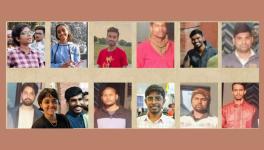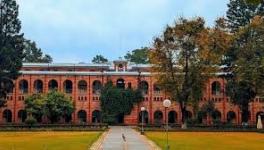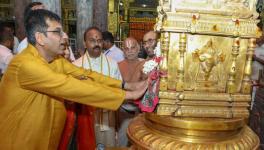A New Book Portrays M.S. Golwalkar as ‘Guru of Gloom’

Review of Golwalkar: The Myth Behind the Man, The Man Behind the Machine by Dhirendra K. Jha. Simon and Schuster. pp. 385
JUST a year before the showdown between the Marathas and the Durranis seemed inevitable at the Third Battle of Panipat, a pack of Brahmins belonging to the Karhade stock was sent off from their ancestral village by Peshwa Balaji Baji Rao, the Prime Minister of the Chhatrapati, the king of the Maratha dynasty.
It was brought to the Peshwa’s notice that on the eve of Dussehra, the Karhades of Golwali performed the heinous act of human sacrifice to satiate the presiding goddess of their local temple. The Peshwas, who had belonged to the Chitpavan stock of Brahmins, had harboured a grudge against the Karahades for a long time.
The human sacrifice episode presented a unique opportunity for the Peshwa to strike. The Peshwa revoked the hereditary rights over 72 villages enjoyed by the Karhades. Saddened by their loss, the outgoing Brahmins cursed the Peshwas— that their might would soon be destroyed. Coincidentally, the curse unfolded. The Peshwa was defeated at the hands of Ahmad Shah Abdali in the Third Battle of Panipat.
Saddened by their loss, the outgoing Brahmins cursed the Peshwas— that their might would soon be destroyed.
The Brahmins of Golwali roamed around and resettled in other parts of the subcontinent. Almost 150 years later, Madhav Sadashiv Golwalkar was born to a family of the displaced Karhades.
Since the history of Hindutva is centred on revenge and vengeance, one would have expected Golwalkar to have a vengeful attitude towards the Chitpavans. Instead, he came under the ideological influence of a Chitpavan Brahmin, V.D. Savarkar, who in turn exhorted his followers to turn their guns on religious minorities. Muslims to be precise.
Dhirendra Jha begins his book Golwalkar: The Myth Behind the Man, The Man Behind the Machine by demolishing one of the myths surrounding Golwalkar alias Guruji. Jha shows that Golwalkar had never been a professor at the Banaras Hindu University (BHU). Instead, he was a lab assistant filling in for a temporarily vacant post whose permanent holder was on leave.
Immediately, the reader is taken back to the 2014 Lok Sabha elections wherein Narendra Modi had lied about his educational qualifications. The habit of lying seems to go back to Guruji. One must, therefore, excuse the disciple.
Jha writes, ‘‘Apparently Golwalkar had a sense of himself as an intellectual, and this might have led him to harbour an ambition to become a professor one day … a position that commanded respectability in society, especially among the middle and lower middle classes … by telling the world that he had once been a ‘professor’, he seemingly hoped to enhance popular admiration for himself as a learned person.’’
Narendra Modi, too, had his constituency in mind— the tax-conscious, aspirational neo-middle classes who have perfected the art of mixing global aims and localised outlooks. A leader who has never attended college would have seemed a tad bit unworthy of the grand task of making India a Vishwaguru (teacher of the world).
Born to a family with limited financial resources, Golwalkar was not, as alleged by his hagiographers, a brilliant student. He passed the matriculation examination with a second class. He also failed to enrol himself in a medical college for lack of marks.
Since the history of Hindutva is centred on revenge and vengeance, one would have expected Golwalkar to have a vengeful attitude towards the Chitpavans.
After passing the bachelor of science examinations from the Banaras Hindu University, Golwalkar went to Madras (as it was then). There, he was promised a scholarship for doctoral studies by an unknown benefactor. Surprisingly, the benefactor did not meet Golwalkar for months.
At that time, Madras was a hotbed of anti-caste politics. The ink in E.V. Ramaswamy Naicker’s ‘Periyar’ pen was boiling as he scripted some of the hottest criticisms of Hinduism and the caste system. Unable to either understand or connect himself with the liberating environment, the orthodoxy within Golwalkar strengthened.
On February 9, 1929, Golwalkar wrote to his friend Tailang, ‘‘I have not found even a small basis of Untouchability in the Manusmriti.’’ It must be remembered that Babasaheb B.R. Ambedkar had burnt the Manusmriti in 1927.
Throughout his life, Golwalkar remained an ardent supporter of the caste system. In 1956, he declared the caste system ‘‘the best order for achieving human happiness and a supreme and scientific social order based on the division of labour”.
In 1969, Golwalkar’s comment, ‘‘The caste system had been created by God and everyone should do his duty according to his caste,’’ caused massive protests. The Rashtriya Swayamsevak Sangh (RSS) unit of Bombay (as it was then) had to cancel Golwalkar’s visit due to the protests.
A professionally unsuccessful life led Golwalkar towards spiritualism— the only way to gain respect and some standing in a conservative society. His wanderings led him to the Ramakrishna Mission, an order of monks started by Narendranath Datta alias Swami Vivekananda.
Even at the mission, Golwalkar was almost a failure. Swami Akhandanand, the chief abbot, had refrained from giving diksha (spiritual initiation) to Golwalkar. Only towards the end of his life did Swami Akhandanand decide to give diksha to Golwalkar. The diksha was carefully caveated. Swami Akhandanand had told another disciple, Amurtanand, to keep Golwalkar away from the ashram.
A forlorn Golwalkar returned to Nagpur, Maharashtra. Soon an opportunity arose that helped Golwalkar to leap out of a life of anonymity. His translation of Swami Vivekananda’s famous speech delivered at the World Parliament of Religions in Chicago brought him local fame.
The Marathi book Rashtriya Mimansa Wa Hindusthanchen Rashtraswaroop by Ganesh ‘Babarao’ Savarkar (V.D. Savarkar’s elder brother) came to Golwalkar for translation into English.
Born to a family with limited financial resources, Golwalkar was not, as alleged by his hagiographers, a brilliant student.
The book was soaked in the hate-broth prepared earlier by the younger Savarkar. How India belonged to the Hindus and not to the religious minorities was the chief claim of the book. For some obscure reason, the English translation of Babarao’s book never came out.
The process of translation had a lasting impression on Golwalkar. Jha writes, “Golwalkar’s involvement in its translation marked the beginning of his integration into the elite circle of Hindutva politics.’’ It is also surprising how Vivekananda’s speech, famous for presenting a very humane and tolerant view of Hinduism, did not have a calming impact on Golwalkar.
The nucleus of the RSS was formed when Babarao visited Nagpur in 1924 and started staying in its Mahal locality. During his almost year-long stay, Babarao interacted with youths (almost all Brahmins) daily. Soon a group of youths emerged vowing to dedicate their lives to the cause of Hindutva.
When Babarao left Nagpur, he handed over the responsibility of the group to Keshav Baliram Hegdewar. In September 1925, the RSS was formed under Hedgewar’s leadership. Golwalkar soon merged his brook with the RSS.
Golwalkar’s ambitions were swelling, writes Jha, “But his ego was not immediately gratified by Hedgewar, who had someone else in mind for the leadership role.” That someone was Gopal Mukund Huddar. Unfortunately for Hedgewar and fortunately for Golwalkar, Huddar ended up fighting against the fascists in the Spanish Civil War (1936) along with the Communists.
A radicalised Huddar returned to India and beseeched Hedgewar to fight against British imperialism. Hedgewar’s hitch with the British and his penchant for communalism was too strong to heed his favourite disciple’s advice. As Huddar went ahead and joined the Communist Party of India (CPI) to wage a political war against the British, Golwalkar came closer to Hegdewar.
On February 9, 1929, Golwalkar wrote to his friend Tailang, ‘‘I have not found even a small basis of Untouchability in the Manusmriti.’’
After Hegdewar’s death, Jha, through a series of cross-references, has shown that Golwalkar self-crowned himself as the next head of the RSS. Golwalkar had stayed close to Hedgewar during his last days. This allowed him to cook an unverifiable story of Hedgewar’s final wish to see Golwalkar as the next chief of the RSS.
Golwalkar cemented his place within the RSS through his text We or Our Nationhood Defined. Published in 1939, the book went on to become a holy book for the swayamsevaks (RSS volunteers). The book exhorted Hindus to follow the Nazis in matters of race pride. It proscribed the Muslims as a foreign race and prescribed a ‘final solution’ akin to the ones administered to Jews in Nazi Germany.
In later chapters of the book, Jha has laboured hard to show that the denial of Golwalkar’s authorship of the text is one of the many lies spread by the RSS. In May 1963, on the eve of V.D. Savarkar’s eightieth birthday celebration, Golwalkar had lied to the public that We or Our Nationhood Defined was an abridged translation of Babarao Savarkar’s Marathi book Rashtra Mimansa.
Jha shows that in two hagiographies of Golwalkar published in 1956, the authors, B.N. Bhargava and N.H. Palkar, had respectively written: We or Our Nationhood Defined as an “unassailable exposition of the doctrine of nationhood … establishing the truth of his (Golwalkar’s) thesis”. They had also written, “What Golwalkar wrote in his book is the only proper way to look at the question of minorities in India … and this alone can ensure stable and peaceful national life.”
Time and again, saner and secular voices in India raised an alarm about the vile contents of the book. For instance, in 1962, P. Kodanda Rao, a social activist based in Bangalore (as it was then), wrote to Golwalkar to ascertain his views championed in the book.
Golwalkar neither acknowledged the receipt of Rao’s letter nor replied to it. Rao went ahead and shot letters to J.L. Nehru and Lal Bahadur Shastri to acquaint them with the communal nature of the book. He also wrote articles for several English dailies and journals to apprise the public about the book.
The RSS’s first big test came within two months after Hedgewar’s demise. Under the Defence of India Act of 1939, in August 1940, the imperial government imposed restrictions on the functioning of quasi-military operations.
Instead of resisting the British, the RSS, under Golwalkar’s leadership, curled inwards and looked for safer havens to operate. The Hindu Princely States soon became the breeding grounds for the RSS and the Hindutva ecosystem. Even in these petty kingdoms and chiefdoms, Jha shows, the RSS started working with changed names to flatter the rulers.
Golwalkar’s ambitions were swelling, writes Jha, “But his ego was not immediately gratified by Hedgewar, who had someone else in mind for the leadership role.”
For instance, the Kolhapur unit was named ‘Rajaram Swayamsevak Sangh’ after the name of the kingdom’s former ruler. In Bhor, the RSS unit was called ‘Raghunathrao Swayamsevak Sangh’ named after the incumbent ruler. Through this, it seems that the seva and loyalty of the swayamsevaks were cheaply available for those seeking to buy it.
Another facet of this association with decrepit princelings was the RSS’s endorsement of their secessionist dreams. Brijendra Singh, the king of Bharatpur, the sole Jat kingdom in India, had prepared a map of an independent state of ‘Jatistan’.
Singh was very close to Golwalkar and in 1946 he had called an all-India conference of RSS sanghchalaks (managers). Bharatpur served as a breeding ground for the RSS. Bacchu Singh, Brijendra’s younger brother had carried out brutal attacks on Muslims in Bharatpur.
On the eve of independence when the frenzied monster of communalism started consuming the lives of innocents, the RSS and Hindutva elements were seen appeasing the monster.
It is estimated that at the time of the Partition of British territories in the subcontinent, almost 250,000 RSS members were active in India. Jha has done a great job of depicting the violence in Delhi. He has shown how the RSS instrumentalised the anger of Hindu and Sikh refugees coming from West Punjab.
When violence erupted in the first week of September 1947, the RSS played a yeoman’s role in organising it. Nehru tried his best to contain the violence but he was ploughing a lonely furrow within the Congress as Patel sympathised with the RSS and allowed its hoodlums to run amok.
The conservative streak within the Congress ran strong. M.S. Aney, a Congress conservative, had written the foreword for the first imprint of Golwalkar’s We and Our Nationhood Defined. It was Gandhi’s return to Delhi, his rebuke to Patel, his indefinite hunger strike in early January 1948 and a groundswell generated by students, socialists, communists and secularists that stopped the RSS’s planned coup.
It was Gandhi’s secular steadfastness that led forces of Hindutva to call for his murder. Through the Delhi Police Records, Jha has shown that in a meeting held at the Rohtak Road Camp, an aggressive Golwalkar threatened that “even Gandhi could be silenced”.
Jha has shown that in a meeting held at the Rohtak Road Camp, an aggressive Golwalkar threatened that “even Gandhi could be silenced”.
Gandhi was indeed silenced in less than two months of Golwalkar’s speech. But silencing Gandhi ended up mummifying the RSS, at least politically. The badge of ignominy hung on the heads of the black caps for a very long time.
The book goes a long way in exposing Golwalkar’s life. Even neutral readers would conclude that he was nothing but a merchant of hate who lived a life of conniving secrecy.
My favourite quotation from the book is that of Jawaharlal Nehru. On October 2, 1947, whilst addressing Congress workers on the birth anniversary of Gandhi, Nehru said: ‘‘I strongly oppose the demand for making India a Hindu State. This is not my personal view, but it has the support of my government and the entire Congress organisation.
“The demand for a Hindu State is not only stupid and medieval but also fascist in nature. Those who put forth such ideas will meet with the same fate as Hitler and Mussolini.’’
Get the latest reports & analysis with people's perspective on Protests, movements & deep analytical videos, discussions of the current affairs in your Telegram app. Subscribe to NewsClick's Telegram channel & get Real-Time updates on stories, as they get published on our website.
























